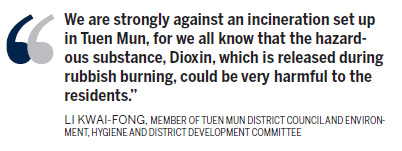Incinerator on landfills sparks protests
Updated: 2010-10-26 07:16
By Michelle Fei(HK Edition)
|
|||||||||
Hong Kong Baptist University's proposal to build solid rubbish incinerator in each of the five legislative districts in Hong Kong sparked angry protests Monday. Its proposal followed a study that the solid rubbish incinerators can serve as both a waste remover and a green energy producer.
District council member of Tuen Mun, where one of the incinerators is planned to be built in two-three years, slammed the proposal for the "potential air pollution" it might cause.
"We are strongly against an incineration set up in Tuen Mun, for we all know that the hazardous substance, Dioxin, which is released during rubbish burning, could be very harmful to the residents," said Li Kwai-fong, member of Tuen Mun District Council and Environment, Hygiene and District Development Committee.

"The key to reducing Dioxin is sorting waste and recycling," said Victor Sit, director and chair professor of Advanced Institute for Contemporary China Studies, arguing that the chlorine that comes out during plastic burning is the major cause of Dioxin.
Professor Xia Bei Cheng, the study conductor from Sun Yat-sen University in Guangzhou, said emission of Dioxin could be significantly reduced by closely monitoring the heat of the furnace, the time of burning, filtering and collecting the exhaust gas, etc.
"Rubbish incinerating is the most effective way to deal with the problem of ever-increasing volume of rubbish," said Victor Sit. He added that the solid rubbish incinerators are used all over the world, especially in European countries, Japan, Singapore, Macaw and the mainland.
According to the study, by 2025 every person in Hong Kong will produce 4.5 kilograms of rubbish on average everyday, which is two to three times higher than that in Japan, Singapore and Korea. And most of it will be dumped on the landfill. It is also estimated that by 2012, the landfill in Southeast New Territory will reach a point when it will have to be shut. And between 2015 and 2016, the same will happen in the remaining two, one in Northeast New Territory and the other in West New Territory.
The incinerator can consume 10,000 tons of solid rubbish a day, which accounts for more than 10 percent of the total volume of wastes.
Two incinerators are proposed to be initially built in Tuen Mun and Shek Kwu Chau by around 2013. Each will cost HK$0.1 to 0.2 billion.
Environment Secretary Edward Yau confirmed Monday that the government is looking for suitable sites. However, he insisted that burning rubbish cannot be the only solution; more landfills are still needed.
China Daily
(HK Edition 10/26/2010 page1)